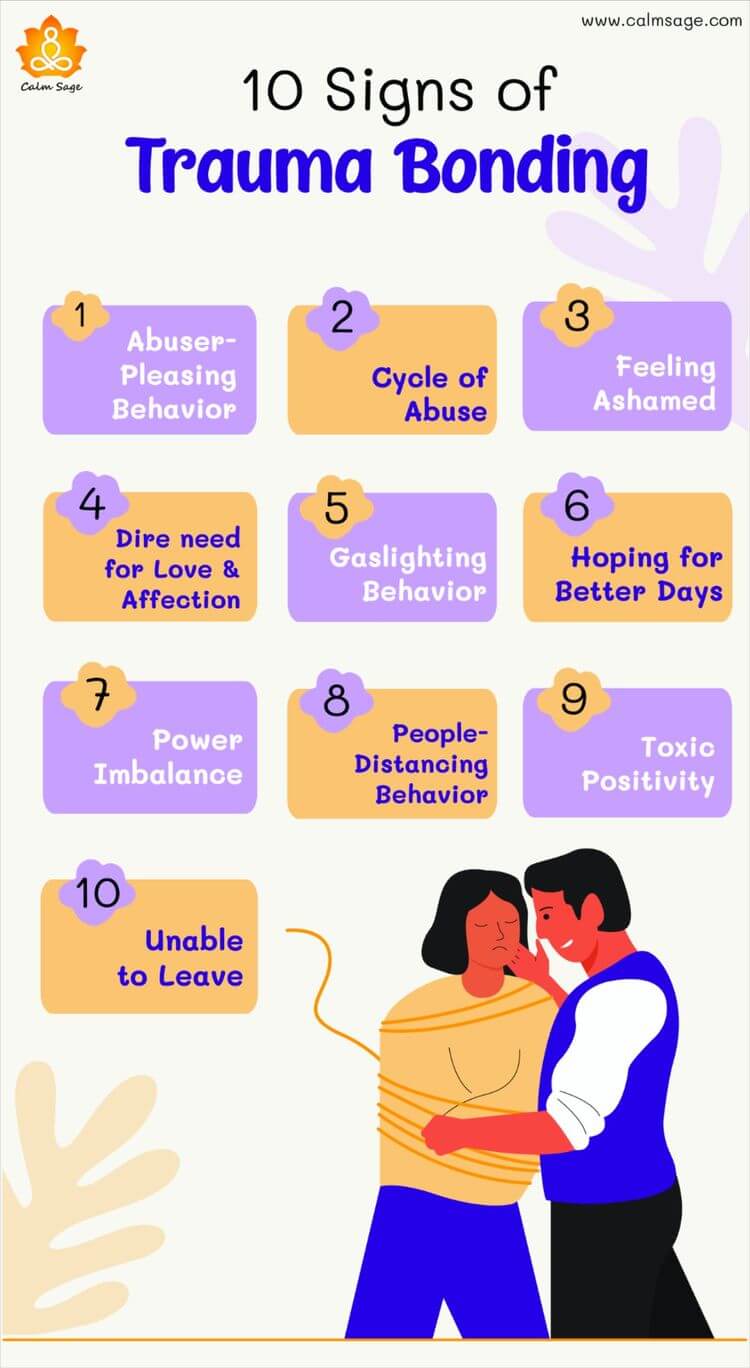Trauma Bonding: 10 Important Signs You’re Trauma Bonded

The content in this article is thoroughly researched and written based on the extensive testing and reviewing by a reviews team and does not reflect the viewpoints of the Calm Sage editorial team. Calm Sage could receive a commission from product purchased mentioned or featured in this article.
Key Points:
- A trauma bond is known as an emotional response to abuse. Trauma bonding can happen during child abuse, domestic abuse, elder abuse, exploitative employment, hostage-taking, or kidnapping
- Power balance and the dire need for affection or love are the most common signs of trauma bonding.
- Recognizing the cycle of abuse is an essential step for breaking trauma bonds.
- In order to leave a toxic or abusive relationship, it’s important to reconcile a sense of self.
- Trauma bonding is rooted over the psychological effects of childhood wounds or trauma.
It’s hard to say but the truth is that when you’re exposed to an abusive relationship, you’re a victim of manipulation and trauma as well. In order to overcome such abusive relationships, it’s important to recognize their signs especially before they get converted into trauma bonding. Trauma bonding is a phenomenon that happens when an abusive relationship gets converted into a cycle of abuse.
Trauma bonding can be seen by abusive behavior along with acts of affection and kindness followed again by the cycle of abuse. This phenomenon is also referred to as Stockholm syndrome which is a psychological response to trauma. In this blog, we will be taking a deep look at the 10 important signs of trauma bonding.
Before starting, please know that this blog contains abuse and a cycle of abuse. If the content presented in this article is difficult to read or triggers trauma, please move forward to the conclusion section to find support.
What is Trauma Bonding?
In psychology, a trauma bond is known as an emotional response to abuse. Trauma bonding is likely to occur when the abused person forms affection, care, or connection for the person who abuses them.
Specifically, during trauma bonding, an abused person is likely to develop sympathy for the abuser which is reinforced by the cycle of abuse. This bond can develop for days, weeks, or even months.
Psychologically, trauma bond is not experienced by all victims, it is a specific type of trauma bond. Now, the question is when can trauma bonding happen? Well, trauma bonding can happen during the below-listed situations:
- Child abuse
- Domestic abuse
- Elder abuse
- Exploitative employment
- Hostage-taking or kidnapping
- Human trafficking
- Incest
- Religious extremism
To read more about trauma bonding and the cycle of abuse, refer to: Trauma Bonding: What is it and how to cope with it?
10 Important Signs of Trauma Bonding

1. Abuser-pleasing behavior
Victims who are emotionally attached to their abuser might believe in pleasing the abuser as they are always hoping for the best and trying to make their relationship work. In some cases, victims intentionally please the abuser because of their support (for example: financial aid).
Scientifically, when a victim starts trauma bonding with the abuser, it results in the release of dopamine, and it acts like a reward for the abuser. In some cases, the victim becomes addicted to high-dopamine-producing activities.
2. Cycle of Abuse
When the relationship becomes toxic or abusive, it’s important to recognize the toxic signs and decide whether to move on or stay. But if you focus on an abusive relationship, you’ll find that not all days are abusive, some are full of love or some are full of guilt. Sometimes, an abuser apologizes, promises, shows affection, and does everything that is required to make a relationship look perfect.
Sadly, the cycle of abuse does not end here, the cycle of abuse keeps on going (stress—abuse—reconciliation—calmness—abuse). Generally, all types of abuse (emotional, physical, verbal, sexual, or psychological) revolve around the cycle of abuse. And, it’s very important to recognize this cycle in an abusive relationship.
3. The dire need for love and affection
When we are victims, we are in dire need of love and affection despite the abuse happening to us, due to which, we often stop balancing things and start focusing on the positive side only. Additionally, victims often lack self-esteem and the dire need for love and affection is a part of the cycle of abuse.
4. Feeling ashamed
The victims often feel ashamed of their abuse and the abuser, but due to growing love and affection they ignore the consequences and keep on tangling themselves in abuse. This behavior keeps on making the cycle of abuse stronger.
5. Gaslighting behavior or making excuses
The victim usually makes excuses in front of the abuser to avoid violence or in front of people to make the abuser look good. For example, I have seen so many instances wherein the victim takes the side of an abuser by saying, “It’s okay, the fault was mine, it’s not that bad, or I made them jealous.” Such excuse-making does not justify their abusive behavior.
Additionally, gaslighting is a major sign of trauma bonding. During gaslighting, the abuser usually tries to manipulate the victim by making them feel bad about the abusive situation.
6. Hoping for better days
The victim often tries to keep the abuse a secret in the hope of better days. They might excuse the behavior but they never understand that the consequences of such ignorance can become really intolerable in the future. Trauma bonding can result in powerful emotional attachments which might make the victim fall in love again and again with the abuser and can make the cycle of abuse more harmful.
7. People-distancing behavior
When trauma bonding begins in a relationship, victims generally start distancing people who are coming for their support. In some cases, abusers also distance the victims from the support systems so that abusers can take the place of the support system and become trustworthy again. The abusers often keep the mentality that the fewer people around, the more chances there will be to reconcile the relationship or gain control over the victim.
8. Power imbalance
It’s a fact that abusive relationships make abusers powerful and make victims look powerless. When an abuser holds power over everything, the victim becomes imbalanced and due to this, it becomes harder to leave the abusive relationship. Due to power imbalance, the victim starts feeling that they are defined by the relationship in some cases.
9. Toxic positivity
The cycle of abuse becomes so toxic that the victim starts feeling love for the abuser again. The victim starts seeing the positive or bright side instead of focusing on maintaining a healthy relationship. They often forget that “no amount of affection or kindness can outweigh physical or emotional abuse.”
This thinking often results in trauma bonding and toxic positivity.
10. Unable to leave
Due to power imbalance, sometimes, the victim is unable to leave even after so many episodes of abuse. This happens because they lose their sense of self. It takes a lot of courage to step outside the relationship or become their own support.
Usually, psychotherapy can help someone cope with trauma bonding and provide support to step outside the relationship by breaking the toxic attachment. Additionally, the threat of physical violence also makes a victim unable to leave. The fear of increased violence plays a major role in the victim’s leaving an abusive relationship.

Psychological Effects of Trauma Bonding
One of the common psychological effects of trauma bonding is the developed feelings for the abuser which not only forces the victim to stay in the relationship but also impacts the overall well-being of the victim negatively. in some severe cases, it can also lead to worse cases of abuse or even death (because of growing abuse).
If the victim decides to leave the relationship, they might experience a lack of self-esteem in the first which can also convert in the form of severe anxiety, depression, or even PTSD (if not diagnosed or treated). Research shows that this can also lead to an intergenerational cycle of abuse due to trauma bonding.
How to Break Traumatic Bonds?

Traumatic bonds are hard to break, in some cases, they are even impossible to break. However, there are a few strategies that can be used for moving out from a traumatic bond:
1. Separate yourself slowly:
If you think you or your friend is indulged in a traumatic bond, the first step is to recognize the cycle of abuse and signs of trauma bonding. After that, try separating yourself slowly out of the toxic relationship so that you can also get time to understand your emotions, process the trauma, and make safety plans for yourself and your children (if involved).
2. Create a support system:
While doing so, create a support system, start connecting with your loved ones, family members, friends, or colleagues who can provide you support. During the process, create a crisis plan with them and share it with them so that they can support you during emergency situations.
3. Work on your suppressed emotions:
During the healing process, you’re likely to get involved in the signs of trauma bonding again and again due to the cycle of abuse and the gaslighting behavior of the abuser, remind yourself of the trauma they’ve given you several times and this time don’t allow them to come nearby or manipulate you again and again.
Additionally, try to work on your suppressed emotions so that you can set healthy boundaries for yourself and come out of this toxic relationship.
4. Practice positive self-talk:
Lack of self-esteem is one of the major signs of trauma bonding, therefore, work on becoming independent again and speak kind to yourself so that you can become powerful and break the abusive bond with the abuser.
5. Seek professional help:
Experiencing trauma can have multiple psychological and physical health effects, therefore, psychotherapy can help you escape abusive situations. A trained professional can help you talk about your experiences, feelings, or thoughts and help you learn healthy coping strategies in a safe environment.
All you need to do is to connect with an experienced and registered mental health professional who works specifically for abuse survivors or traumatic experiences.
If you’re looking for help through online platforms, you can refer to:

Great for a large network of licensed therapists
-
$60 to $90/week, billed every 4 weeks
-
Therapy via messaging, phone, or live video chat
-
Flexible cancellation at any time
20% off your first month

Great for CBT Based therapists
-
$40/week, billed every 4 weeks
-
Therapy via messaging, phone, or live video chat
-
Specialization for CBT based Therapy
20% off your first month

Best for Treatment Plants
-
$60 to $90/week, billed every 4 weeks
-
Therapy via messaging, phone, or live video chat
-
Flexible cancellation at any time
$100 off your first month with code SPACE
Takeaway: Getting Support
- Breaking a trauma bond can be challenging but it’s very necessary, in cases of domestic violence, please refer to the: National Domestic Violence Hotline
- In cases of child abuse, please refer to: The Childhelp National Child Abuse Hotline
- In cases of elder abuse, please refer to: Elder Abuse Hotlines
- In cases of immediate danger or emergencies, you can call 911 or call at 800-799-7233
Support groups
Support groups offer help and support to each other by sharing their experiences and stories. In this way, victims feel less alone and are reminded that they must focus on positivity. Additionally, people also share healthy coping tips that can help them move out from abusive situations or traumatic events.
I hope this blog helps you understand the 10 signs of trauma bonding. Comment down your views or you can also write to us at Calm Sage.
Thanks for reading!




















